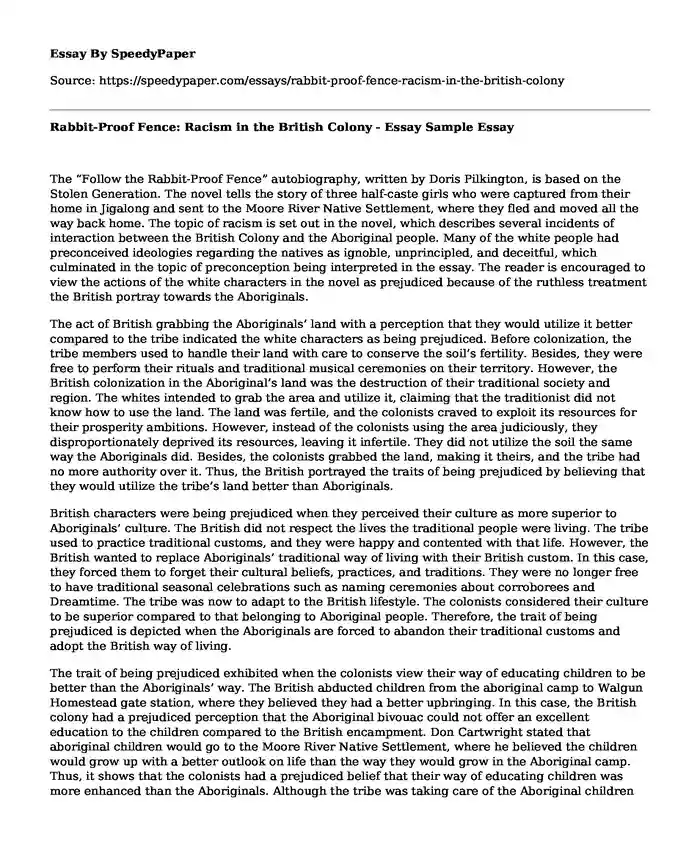
| Type of paper: | Essay |
| Categories: | Racism Literature Abuse |
| Pages: | 3 |
| Wordcount: | 772 words |
The “Follow the Rabbit-Proof Fence” autobiography, written by Doris Pilkington, is based on the Stolen Generation. The novel tells the story of three half-caste girls who were captured from their home in Jigalong and sent to the Moore River Native Settlement, where they fled and moved all the way back home. The topic of racism is set out in the novel, which describes several incidents of interaction between the British Colony and the Aboriginal people. Many of the white people had preconceived ideologies regarding the natives as ignoble, unprincipled, and deceitful, which culminated in the topic of preconception being interpreted in the essay. The reader is encouraged to view the actions of the white characters in the novel as prejudiced because of the ruthless treatment the British portray towards the Aboriginals.
The act of British grabbing the Aboriginals’ land with a perception that they would utilize it better compared to the tribe indicated the white characters as being prejudiced. Before colonization, the tribe members used to handle their land with care to conserve the soil’s fertility. Besides, they were free to perform their rituals and traditional musical ceremonies on their territory. However, the British colonization in the Aboriginal’s land was the destruction of their traditional society and region. The whites intended to grab the area and utilize it, claiming that the traditionist did not know how to use the land. The land was fertile, and the colonists craved to exploit its resources for their prosperity ambitions. However, instead of the colonists using the area judiciously, they disproportionately deprived its resources, leaving it infertile. They did not utilize the soil the same way the Aboriginals did. Besides, the colonists grabbed the land, making it theirs, and the tribe had no more authority over it. Thus, the British portrayed the traits of being prejudiced by believing that they would utilize the tribe’s land better than Aboriginals.
British characters were being prejudiced when they perceived their culture as more superior to Aboriginals’ culture. The British did not respect the lives the traditional people were living. The tribe used to practice traditional customs, and they were happy and contented with that life. However, the British wanted to replace Aboriginals’ traditional way of living with their British custom. In this case, they forced them to forget their cultural beliefs, practices, and traditions. They were no longer free to have traditional seasonal celebrations such as naming ceremonies about corroborees and Dreamtime. The tribe was now to adapt to the British lifestyle. The colonists considered their culture to be superior compared to that belonging to Aboriginal people. Therefore, the trait of being prejudiced is depicted when the Aboriginals are forced to abandon their traditional customs and adopt the British way of living.
The trait of being prejudiced exhibited when the colonists view their way of educating children to be better than the Aboriginals’ way. The British abducted children from the aboriginal camp to Walgun Homestead gate station, where they believed they had a better upbringing. In this case, the British colony had a prejudiced perception that the Aboriginal bivouac could not offer an excellent education to the children compared to the British encampment. Don Cartwright stated that aboriginal children would go to the Moore River Native Settlement, where he believed the children would grow up with a better outlook on life than the way they would grow in the Aboriginal camp. Thus, it shows that the colonists had a prejudiced belief that their way of educating children was more enhanced than the Aboriginals. Although the tribe was taking care of the Aboriginal children before colonialism, when the British inhabited their land, the colonists degraded the traditional system. They believed their way of educating children was more excellent and would benefit the future generation of the tribe. Therefore, the act of the British believing they had a better idea of taking care of children compared to the Aboriginals indicated prejudice.
Therefore, the “Follow the Rabbit-Proof Fence” autobiography portrays the British colony’s prejudiced traits towards the Aboriginal tribe. The British believed they had the best way of utilizing lands compared to the Aboriginals. The colonists grabbed the tribe’s land and started exploiting the resources. Additionally, prejudice is portrayed when the British colony presumes their culture to be superior to Aboriginals’ culture. Therefore, removing cultural and spiritual connections and beliefs of the land, possessing the owned property of the multiple Indigenous tribes, and Europeanizing, the Aboriginal children, clearly describes the prejudice theme.
Reference
Pilkington, D. (2002). Follow the rabbit-proof fence. Univ. of Queensland Press.
Cite this page
Rabbit-Proof Fence: Racism in the British Colony - Essay Sample. (2023, Oct 29). Retrieved from https://speedypaper.com/essays/rabbit-proof-fence-racism-in-the-british-colony
Request Removal
If you are the original author of this essay and no longer wish to have it published on the SpeedyPaper website, please click below to request its removal:
- Incidents in the Life of a Slave Girl
- Literature Essay Example
- "Don't Let Them Catch You" by Molly Patterson, Book Review Essay Sample
- Anne Bradstreet - To My Dear and Loving Husband, Poetry Analysis Essay Sample
- Paper Example. Comparison and Analysis: Vivre Sa Vie, 1962 vs. Raw, 2016
- Essay Sample on Alcoholics Anonymous Support Group Program
- Rabbit-Proof Fence: Racism in the British Colony - Essay Sample
Popular categories




